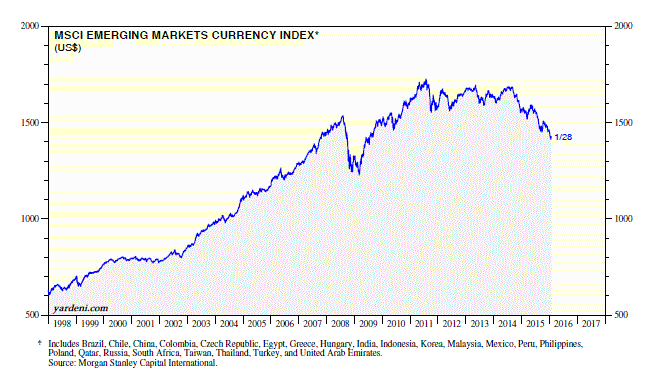How Did We Get Into This Mess?
Despite all the easy money provided by the Fed and the other major central banks, global economic growth is subpar. Indeed, it may be heading into a recession. Inflation remains below the 2% target of the major central banks. Commodity prices are crashing and stock prices have been weak since the start of the year. Consider the following:
(1) High Price Of Easy Money. Today’s problems may be traced to the termination of the Fed’s QE program on October 29, 2014 and the subsequent anticipation of a mere 25bps hike in the federal funds rate, which finally happened on December 16, 2015.
The Fed’s easy monetary policies at the beginning of the previous decade certainly contributed to the subprime mortgage mess. This time, the Fed’s easy money in recent years encouraged borrowers in emerging markets (EMs) to borrow lots of money from banks and in the bond markets to expand commodity production. A significant amount of that debt was in dollars. The prospect of the tightening of US monetary policy after so many years of near-zero interest rates caused EM borrowers to scramble to sell their own local currencies to buy dollars to pay off their dollar-denominated debts.
(2) Scrambling For Dollars. Fed officials have been either blithely oblivious or negligently unconcerned about how the “reach for yield” by investors in the US might have facilitated the capital flows into EMs, which now have been reversing, as evidenced by the 15.6% drop in Emerging Markets MSCI currency index since July 9, 2014.
The EMs have had to intervene in the forex markets to slow the descent of their currencies. Their non-gold international reserves have declined $838 billion to $7.4 trillion from July 2014 through October of last year. Of course, some of that decline is exaggerated by the depreciation of reserves held in euros and in yen, though that also has depressed the dollar value of reserves.
From this perspective, the 23% increase in the trade-weighted dollar since July 1, 2014 is to a large extent a massive short-covering rally by EMs. The soaring dollar increased the local currency prices of commodities priced globally in dollars. It’s likely that the plunge in commodity prices might have been triggered by the short-covering dollar rally combined with the tightening of credit for EMs. Of course, the supply-led glut of commodities only made things worse.
(3) End The Fed. Fed officials don’t spend much time analyzing credit market developments and flows of funds, especially on a global basis. The Fed does have an excellent flow-of-funds database for the US. However, it lacks any data on credit derivatives, which might explain why Fed officials were blindsided by the subprime mortgage disaster. The Fed’s research staff conducted no significant research on mortgage credit derivatives prior to the previous financial crisis.
Similarly, this time around, the Fed mostly has ignored the impact of ultra-easy monetary policy on global credit flows, particularly to EMs. That analysis was left mostly up to the Bank for International Settlements (BIS). Just as bad, Fed officials show virtually no interest in the dollar. They take no responsibility for its movements; nor do they try to understand the implications of these movements.
(4) Are EMs subprime? The fear is that all this is leading to another emerging-markets crisis that could set off a global financial contagion similar to what happened in 2008. It’s actually surprising that nothing big has blown up so far. There could shortly be a Venezuela debt crisis, according to the financial press. My relatively optimistic spin has been that the dollar borrowing by EMs has been largely financed in the capital markets, which are better able to absorb shocks and losses than banking systems. Loans to EMs haven’t been sliced and diced into different tranches of credit derivatives as were subprime mortgages.
Of course, there are many high-yield bonds that were priced too cheaply and have seen their yields soar since mid-2014. However, they were never rated as anything other than junk. EMs and junk bonds have been great shorts recently, but I doubt there will be a sequel to “The Big Short” based on them.


